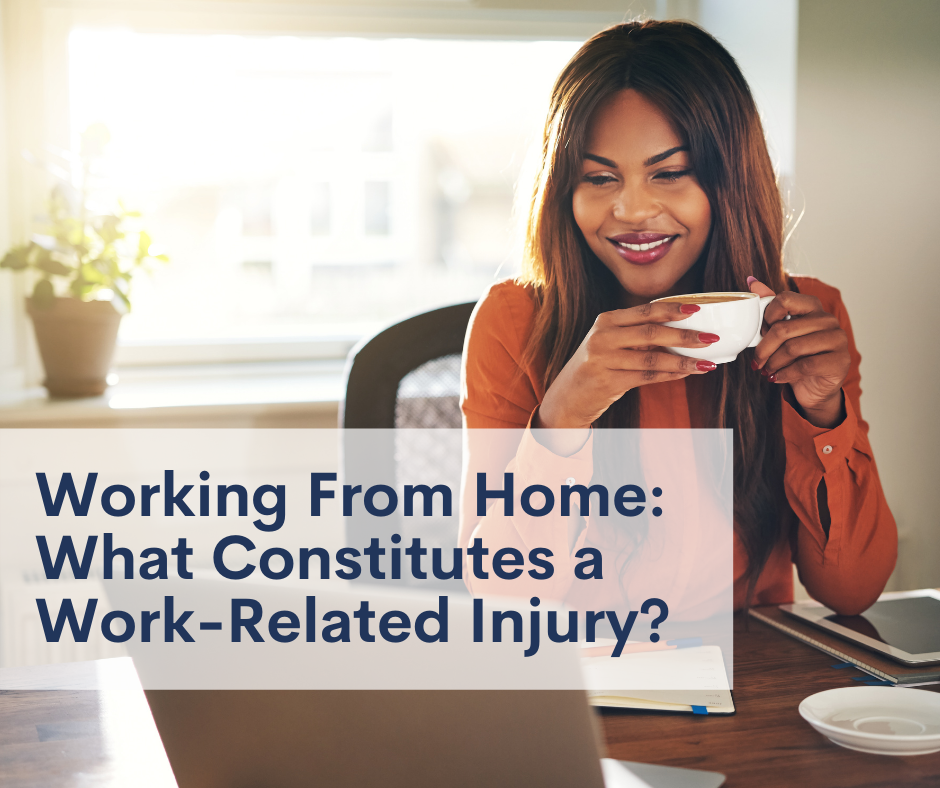
Working From Home: What Constitutes a Work-Related Injury?
By Julie Lambeth, J.D., executive vice president, PartnerSource
It’s Monday morning, the start of another glorious week of working from my home. I will just grab my cup of coffee and head upstairs to my home office to log on. A quick check of my calendar and my to-do list, and the day begins. Oh, but wait! I forgot to add the all-important splash of vanilla latte creamer to my coffee, so back downstairs I go. I’m heading back to my desk from the kitchen when I trip over my dog lying at the top of the stairs, causing me to spill my coffee and burn my hand. Ouch! I head to the sink to run cold water on the burn and, in the process, step on my child’s rogue Lego and fall. If you have ever stepped on a Lego piece with bare feet, you know that the pain is excruciating!
Unfortunately, this chaotic scenario may be all too common today, as more and more employees work from home. It certainly begs the question: Are injuries sustained while an employee is working from home covered under the employer’s occupational injury benefit plan? The answer is grounded in consistent claim investigations and consistent interpretation of plan definitions, and it just may surprise you.
Getting Hurt at Home
The most common types of injuries sustained by remote workers are cumulative injuries and slip, trips and falls. So how does the plan address injuries that occur while an employee is working from home? What does a coverage analysis for remote worker claims look like? As with every claim, the analysis begins with an investigation into whether the business of the employer was being furthered by the activity performed at the time of the incident. It then turns to determining if the incident was directly caused by an occupational hazard, rather than a personal task or personal property.
Many plans today have specific exclusions for injuries caused by personal deviations or personal property. These clauses in the course and scope definition may naturally apply more often to remote workers injured at home. In our scenario above, the personal deviations or personal items that may have caused the incident are clear (unless you happen to work for Starbucks or Fisher Price!).
Analyzing the Injury
If it has been determined that an employee was in the course and scope of employment at the time of the incident, the analysis will look at whether the work activity being performed placed the employee at a greater risk of harm. For instance, an injury sustained as the result of an employee falling on stairs at the workplace may be covered under the plan if it is determined that a causal relationship existed between work and the fall (e.g., the employee was carrying a box of files for work purposes at the time of the incident). The same analysis would apply if a remote worker sustained an injury as the result of falling on the stairs at their home.
What if the employee was injured while on a "personal comfort" break? Would the plan cover an injury sustained on a personal comfort break if the employee was on the employer’s premises at the time? If so, does the plan exclude certain activities during a break? For example, the plan may exclude injuries sustained while the employee is eating or smoking.
Premises are Important
The difficulty of determining coverage for remote worker injuries--especially slip, trip and fall claims--revolves around the premises where they occurred. OSHA recently acknowledged that the employer does not have control over the employee’s home office and an employee’s home does not have to meet the same safety standards as the employer’s workplace.
OSHA’s guidance states:
- It will not conduct inspections of employees’ home offices;
- It will not hold employers liable for employees’ home offices; and
- It does not expect employers to inspect an employee’s home office.
For most work-from home employees, this guidance leaves open the possibility that remote workers may "enter and exit" the course and scope of employment throughout a given work day depending on the task being performed and proximate cause of an incident.
Although OSHA will not conduct inspections of home offices, it does make an exception for injury circumstances involving home-based manufacturing operations. The guidance also confirms that employers will continue to be required to keep records of work-related injuries or illnesses, even if the injury occurs at the employee’s home.
Remote Working Policy
In an effort to minimize remote worker injuries, an employer should develop a policy to establish the terms and conditions of working from home. A remote working policy can further establish what activities are understood to be in the course and scope of employment, establish work hours, designate the work area, and delineate that the employee’s choice to work remotely is voluntary.
Because cumulative injury claims are common for remote workers due to poor home-office work areas, the employer may want to consider providing an ergonomic workstation for the employee’s home use with instruction on how to maximize the benefits of the workstation. The employer may also establish a home safety checklist to be completed by the employee each month to reinforce the importance of maintaining a safe home-office workspace.
Remote worker injuries pose investigative challenges, but the application of plan provisions remains the same regardless of where the injury occurred. The guidance presented in this article applies to most benefit plans drafted by PartnerSource. However, because plan language varies, slight nuances in plan provisions may require a different approach to the analysis.
Have questions? Your PartnerSource team leader is available to discuss your plan and remote worker injuries.
